Acharya Mahapragya (1920-2020)
Life and Times of Acharya Mahapragya
Mahapragya, the tenth Acharya of the Terapanth Sangh, was an encyclopedia of knowledge.A scholar of Jain religious texts, he has contributed
greatly to the understanding and dissemination of Jain philosophy and way of life. Shared below is his inspirational journey.
Mahapragyaji was called Nathmal by his family,which was a Jain Shwetambar TerapanthiAgarwal family. He had an extended family,though he lost his father at a very young age,when he was just two and a half months old.But he was reared up well by his mother very caringly and affectionately.Mahapragya’s mother was a pious woman,whodevoted her spare time to spiritual matters.As there was no formalschool in those days in the village Tamkor in Rajasthan, soMahapragya was devoid of receiving any academic disciplinein an educational context. Instead, his mother was the firstperson in his life to inspire him towards the path of spirituality.She used to chant and recite holy songs which made a deep impacton the young mind.The great soul also received lessons onphilosophy from Jain monks who visited his village.This led toa speedy realisation towards his ardent desire for monkhood.And at the age of ten he became a monk, on 29 January, 1931.Soon began his journey into monkhood under the guidanceof Acharya Kalugani, the eighth Acharya of Jain SwetambarTerapanth, in the town of Sardarsahar (Rajasthan).With this,Nathmal attained the rank of Muni Nathmal. Also, AcharyaKalugani made the required arrangements for Nathmal’sstudies under Muni Tulsi’s classes, who later became theNinth Acharya.This led to a rapid increase in the child’s intellectual developmentand prompted him to receive lessons in themonastery on various subjects of Jain philosophy which includedmemorising thousands of sermons and verses in Hindi,Sanskrit, Prakrit, and Rajasthani languages. Also other subjectslike history, philosophy, logic, grammer, physics,biology,ayurveda, politics, economics, and sociology helped in expandinghis outlook towards a new horizon.And soon by theage of 22, he became an expert and extempore poet, whonever hesitated from demonstrating this skill in many gatheringsof intellectuals. Due to this, Mahapragyaji was popularlyknown as a ‘mobile encyclopedia’. His outstanding intelligencewas a matter of surprise even for the intelligentsia.
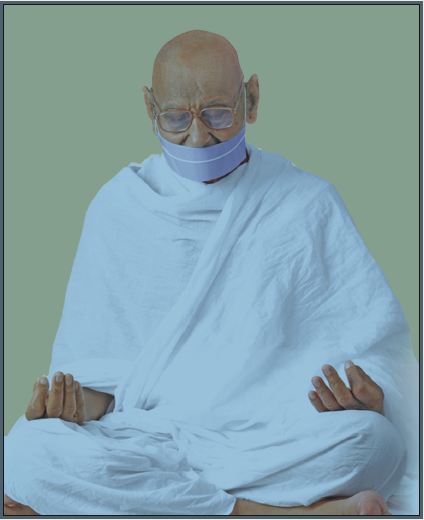
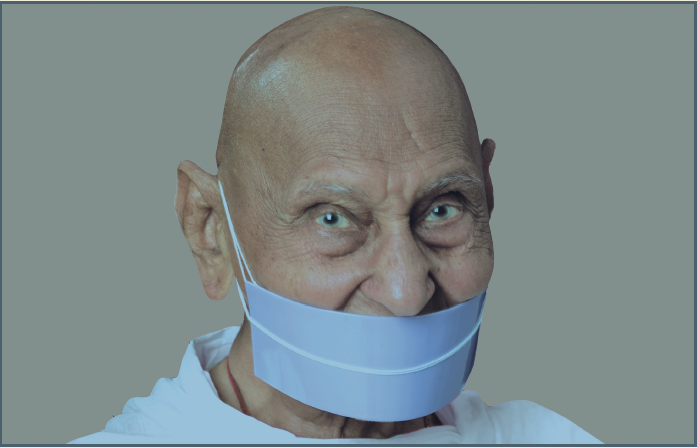
Then he embarked on a journey towards his spiritual endeavours (1945-1978). Mahapragyaji played a significant role in the Anuvrat movement, initiated on 2nd March, 1949 by his guru Acharya Tulsi, the head of Jain Shwetambar Terapanth. The motive of this movement was to inspire millions of people to practice purity and self-discipline in their personal lives. He was not only a core member of this initiative but soon became an active representative for almost 21 years. Again, Acharya Tulsi
the permanent preservation of thousands of years old canonical scriptures.While in his late twenties, Mahapragya started to realise the wonders of meditation, due to which he succeeded in bringing people of different religious sects or castes on one platform. He presented the meditation system in a
Precepts of Monkhood
Mahapragya took five major vows as a part of his initiation to monkhood:
- Ahimsa (non-violence)
- Satya (truth),
- Asteya (non-stealing)
- Brahmacharya (Chastity/Celibacy)
- Aparigraha (non-possession/non-attachment)
As a Jain Muni (monk), he traveled only on foot and would not make use of a vehicle unless and until he was incapable of walking. He did not eat or drink after sunset and before sunrise. He did not cook food and had to go out for alms. He accepted only vegetarian food. He did not own a house. He could not stay in a single place for long periods. He constantly had to change places and could only move in to a house with the owner’s permission. He did not possess anything except for a few basic items like clothes and a bowl for alms.
and Mahapragyaji started a new enterprise which focused on a scrupulous task to research, translate and annotate the Jain Agamas. It began in 1955 in Ujjain with Mahapragya being the editorial director.The work comprises of joint activity involving many intellectual monks and nuns, who played an instrumental role in
well organised and scientific way.The basic four wings of the meditation system can be described as – Meditation, Yogasana and Pranaayam, Mantra, and Therapy.After that Mahapragya conducted hundreds of camps for training in Preksha meditation. He has also written extensively on such topics. Mahapragya was accorded with the designation of ‘Acharya’, and then became Acharya Mahapragya, due to his intuitive sight and effective non-violent actions, striving for unity and amity. He designed the concept of ‘Science of Living’ on 28th
December,1979 at Jain Vishva Bharati,Ladnun,Rajasthan. It focuseson the concept of value-based education and moral educationto ensure the overall growth of the students.This systemstimulates and restores emotions to inculcate a positiveattitude, in order to have an integrated development of personality.Many schools made this effective system a part oftheir curriculum, as it generated surprising results in minimisingstress, promoting efficiency in studies, better concentrationand memory.Acharya Mahapragya began a pathbreaking task whenhe came up with the concept of Ahimsa Yatra. It came into existencewhen he witnessed the necessity of solving the problemscaused by violence. He made his journey on foot so thatthe people are able to follow the dictates of non-violence. Itprimarily focuses on the spiritual aspect of it to ignite theconsciousness of non-violence and to inculcate its valuesthrough its practical aspect which is done by employmenttraining for livelihood.The movement was in motion from2001 to 2009. He passed through 87 districts of India, coveringmore than 2400 villages, towns and cities to appealfor communal harmony and held meetings with many spiritualand political leaders.In 2004, on 15th June, an organisation named ‘Foundationfor Unity of Religious and Enlighted Citizenship’ (FUREC) waslaunched by then President Dr.A.P.J.Abdul Kalam at RashtrapatiBhavan in New Delhi. The thought process behind thisformation was to celebrate inter-religious festivals, multi-religiousprojects, healthcare, and employment, adopting valuebased education in schools and encouraging inter-faith dialogueamong religious leaders.And in order to run the organisationsmoothly and successfully,it required anational level independentand autonomous organisationmanaged by devotedand committed leaders. Italso included scholars andenlightened Citizens for coordinatingall activities. Thisconcept was conceived bythe “Missile Man”, who wasnot only an eminent scientistbut also a great visionary.Kalam put forward a plan,which he described as aroad map for transformingIndia from a less-developedto a progressive society in 20years. For this he conceivedsteps to convert India into afully developed place withprosperous and harmoniouslife for its citizens.And by doingso, the pious and reverentleaders organised a Conclaveunder the assistance ofAcharya Mahapragya atSurat on 15th October, 2003.As a coincidence, the then President also shared his birthday onthe same date.The Action Plan so discussed during the Conclavewas chronicled and is famously known as ‘Surat SpiritualDeclaration’(SSD). FUREC is a collaboration which combinesthe objectives of the Surat Spiritual Declaration and PresidentDr.A.P.J.Abdul Kalam’s Vision 2020. It is a non-profit organisation,founded by 15 dutiful leaders.
![]()
Our ideal is
That we live as belonging to all.
Our ideal is
That we speak like every other.
That no one lives on insufficient gruel.
That we progress,
But the nose does not grow beyond
the forehead.
As the feet of time
Step by step
Move forward
What is true
Becomes newer with every step.
The meaning of new is that it is of use
today.
Don’t blame the mirror
It only reflects the reality.
Change where you stand
For even the Sun is a traveller
Jainism Lit a lamp
In pitch darkness
Eyes closed.
A lamp in my hands I roam.![]()
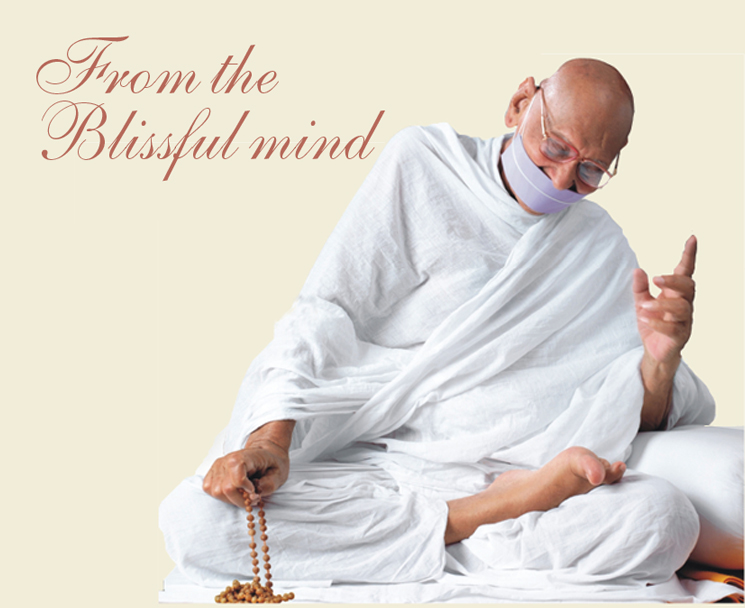
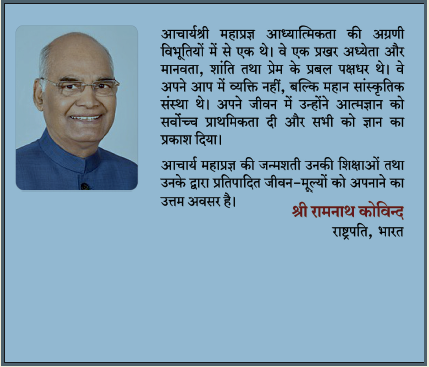
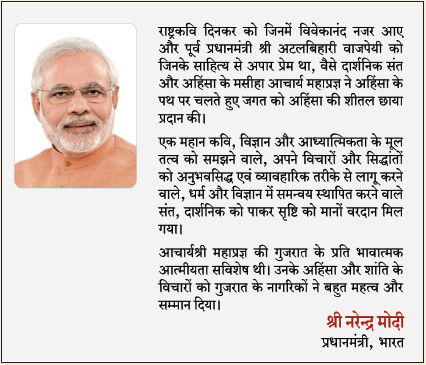
“I felt shaken”
Bharat Ratna, Former President of India, Dr A.P.J. Abdul Kalam
It was the year after India showcased its nuclear prowess in Pokhran that
Dr.A.P.J.Abdul Kalam met Acharya Mahapragya in Mehrauli. Acharya
Mahapragya said to Dr. Kalam, “Kalam God bless you for what you have
done with your team. But the Almighty has a bigger mission for you and
that is greater than what you and your team have done, it is indeed
greater than what any human being has ever done. Nuclear weapons are
proliferating in tens and thousands in the world. I command you and you
only with all the divine blessings at my disposal to evolve a system of
peace wherein these very nuclear weapons will be ineffective, insignificant
and politically inconsequential.”
In the hush that followed, Dr.Kalam felt the confluence of heavens
concurring with the saintly message. He confessed to feeling shaken in the
aftermath of these words. This message of peace gave a new meaning to
Dr. Kalam’s life, and became his guiding light.
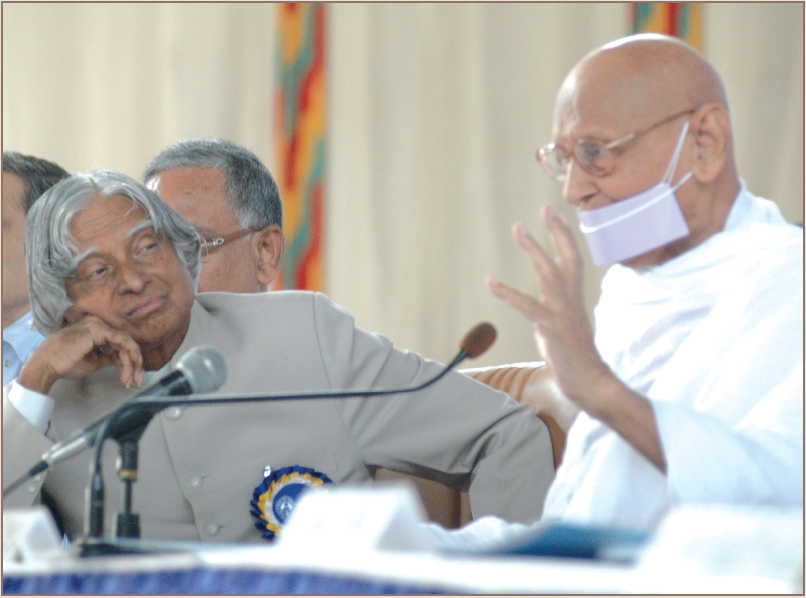
The Jain Way, the Right Way of Life!
Acharya Mahapragya
Original Name
Nath Mal
Date of Birth
14th June 1920
Place of Birth
Tamkor (Rajasthan)
Name of Parents
Shri Tola Ram Choraria & Smt Balu
Jain Asceticism ( Deeksha)
29th January, 1931
Place
Sardarshahar (Rajasthan)
Initiator Guru
Acharya Kalu Gani
Educator Guru
Acharya Tulsi
Acharya Designation
18th February, 1994
Mahaprayan
9th May 2010
Sardarshahar (Rajasthan)
Preksha Dhyan
(Perceptive Meditation)
While in his late twenties, Mahapragya began to explore the marvels of meditation and experiment with spiritual techniques. He also conducted deep research of ancient scriptures,Yoga science, biology, modern physics, naturopathy and Ayurveda.After a practice of over 20 years he formulated
the “Preksha Meditation System” in 1970.This medication system has four wings – Meditation, Yogasana and Pranaayam, Mantra and therapy. Acharya Mahapragya conducted hundreds of camps for training in Preksha meditation with many of them still operative across the globe. He also practised chanting of Mantras daily. He observed from his experiences that the practice of chanting Mantras can help people awaken their hidden powers. It was an impressed Acharya Tulsi who had bequeathed him with the qualitative epithet of Mahapragya (highly knowledgeable) in 1978.
Preksha Dhyan
(Perceptive Meditation)
While in his late twenties, Mahapragya began to explore the marvels of meditation and experiment with spiritual techniques. He also conducted deep research of ancient scriptures,Yoga science, biology, modern physics, naturopathy and Ayurveda.After a practice of over 20 years he formulated
the “Preksha Meditation System” in 1970.This medication system has four wings – Meditation, Yogasana and Pranaayam, Mantra and therapy. Acharya Mahapragya conducted hundreds of camps for training in Preksha meditation with many of them still operative across the globe. He also practised chanting of Mantras daily. He observed from his experiences that the practice of chanting Mantras can help people awaken their hidden powers. It was an impressed Acharya Tulsi who had bequeathed him with the qualitative epithet of Mahapragya (highly knowledgeable) in 1978.
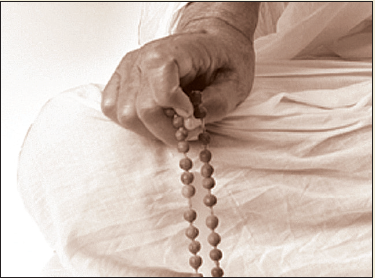

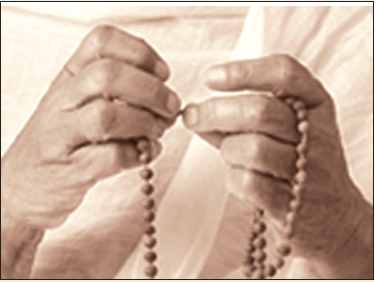
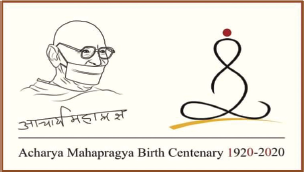
Anuvrat Movement
Mahapragya played an instrumental role in the Anuvrat Movement launched in 1949 by Acharya Tulsi.The moral movement was aimed to create a socio-political world order based on a world-wide network of selftransformed people who followed Jain values. The Anuvrat movement is founded on the Jain doctrines of:
Ahimsa – non-violence Aparigraha – non-possession Anekant – non-absolutism Since its inception, the movement has inspired millions of people to practise purity and self-discipline in their personal life.
Aagam Sampadan
In 1955, Acharya Tulsi commenced the re
search translation and annotation of the Jain Aagams with Mahapragya being the editorial director. The joint efforts of Acharya Tulsi, Mahapragya and other intellectual monks and nuns helped ensure the permanent preservation of thousands of years old canonical scriptures.It took years to complete the Hindi translation of the 32 Aagam scriptures. Their translations and commentaries are viewed with respect by
DNA,hormones and the endocrine system. In his book,Art of Positive Thinking¸ he explored the root cause of negative thoughts and provided a methodology for its transformation. Some other book titles include Towards Inner Harmony, I and Mine, Mind beyond Mind, Mysteries of Mind,New Man New World, and Mirror of Self.
He also wrote extensively on Preksha meditation. Through his writings, he described

AHIMSA YATRA
Harmony | Morality | De-addiction
Acharya Mahapragya during Ahimsa Yatra
The world’s problems touched Acharya Mahapragya deeply. In response, he came up with the solution of Ahimsa Yatra, a journey on foot to advance the cause of non violence, which was launched by Mahapragya on 5 December, 2001 at Sujangarh in Rajasthan. With Ahimsa Yatra,Acharyaji’s mission is to train and spread non-violence and its broad perspective to people. It is an endeavour to awaken a new faith in the infinite power of non-violence. It
aims at bringing the problems of all forms of violence into sharp focus. Its
mission is to provide training for transforming the negative thoughts/emotions into a positive direction.The spiritual aspect of non-violence training is to ignite the consciousness of non-violence and to cultivate
the values of non-violence.And its practical aspect is the employment
training for livelihood. Having eschewed violence and pledged to refrain from killing innocent creatures, political leaders, social workers, and spiritual leaders came to him for advice. He took his Yatra from Gujarat to Maharashtra, Daman, Madhya Pradesh, Haryana, Delhi, some parts of Uttar
Pradesh, Punjab,and Chandigarh. He passed through 87 districts of India, and covered more than 2400 villages, towns and cities, where he held meetings with many spiritual and political leaders and appealed for communal harmony. Approximately, 40,000 volunteers were assigned various responsibilities in their local areas.
This Yatra allowed him to come into direct contact with farmers and common and poor people of the villages which he visited. He stopped at all the small villages on his route and held open mass meetings.Through this public speaking,Acharyaji created awareness on the broad perspectives of non-violence, unemployment eradication, leading a life free from drug addiction, bad habits,communal harmony, healthy living,and harmonious social and personal lives. Side by side, volunteers spread out in different directions in order to establish personal contact with families afflicted by drug addiction,unemployment, and stress.These volunteers were then to stay behind in order to help solve those problems.Verily the villages and towns covered by the Acharya became centres of training in ahimsa.
The Yatra concluded on January 4, 2009 at Sujangarh, the same place where it had been begun
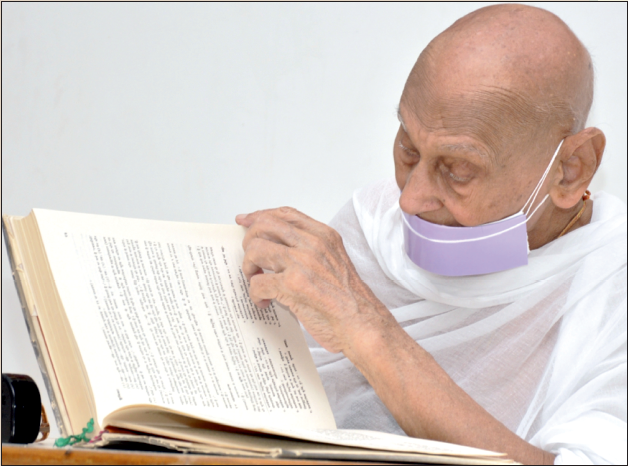
Major Awards
and honours
Mother Teresa National Award of Peace by Inter faith Harmony Foundation of India in 2005
Communal harmony award i.e. Sampradayika Sadbhavana Puraskar by Govt. of India in 2004
Ambassador of Peace (London) by Inter Religions and International Federation in 2003
Lokmaharshi by New Mumbai Municipal Corporation in 2003
Indira Gandhi National Integration award in 2002
D.Litt by Netherland Inter Cultural Open University in 1999
On the eve of Acharya Mahapragya birth anniversary, all religious dharm guru’s of Karnataka state honoured in as “DHARM CHAKRAVARTHI” (2004)
In 2008,”SARVA DHARM SAMMELANA” held at Town Hall, Bangalore and participated in by all religious gurus felicitated Acharya Mahapragya as “VISHVA SHANTHI DOOT”
KABIR PURASKAR GOVT. OF INDIA 2004
Ahimsa Award, Institute of Jainology,
London 2008

the heads of other sects as well as intellectuals and oriental scholars from the East and the West. Mahapragya’s contribution in this historic endeavour was outstanding, as it attempted to render the obscure literature comprehensible and interesting. Mahapragya uncovered numerous Aagam mysteries and presented root philosophies as well as Mahavira’s philosophy and vision in this commentary.
Ahimsa Samvaya
Mahapragya’s vision of unifying the forces of Ahimsa at a global level culminated in the establishment of Ahimsa Samvaya in 1999.Ahimsa Samvaya is a forum to unite forces of peace and non-violence with mutual understanding and love.
Sahitya Srijan
(Writings of Mahapragya)
Mahapragya started writing when he was 22 years old, authoring more than 300 books in his lifetime. The prolific writer made massive contribution to Sanskrit and Hindi literature through his writings.These works cover topics like meditation and spirituality, the mind, the human psyche and its traits, the roots of emotions and their manifestation through behaviour, Mantra Sadhana, Yog, Anekantavada, non-violence, Jain philosophy and history. His most noteworthy achievement was to consolidate the Jain concepts of karma and human behaviour with the views of modern biology in areas such as genetics,
various techniques of meditation and their effects on the psyche, physiology, hormonal influences, the endocrine system and the nervous system.
He has done extensive work on anekantavada, the philosophy of non absolutism and relativity. He showed ways how one can improve the thought process with Anekant and use it for a peaceful life and co-existence. His book Anekanta The Third Eye discussed the details of the philosophy. He has written many books on Jain Philosophy, providing serious material on Jain beliefs and vision.
Jain Darshan: Manan and Mimaansha and Philosophical Foundations of Jainism explain numerous deep facets of the Jain belief system. Mahapragya also wrote extensively on the lives and philosophies of Acharya Bhikshu and Acharya Tulsi. Shraman Mahavira is his biographical work on Mahavira. Mahapragya also made great contribution to Sanskrit through his poetry. Mahapragys wrote with great clarity and a direct style. His language was conscious of relativity even in expression. He often resorted to the passive voice. As one of his translators once said, “Between one full stop and the next sentence, a kingdom can be built”.
This humble initiative in the form of a tribute is a grateful acknowledgement of what we can learn from ‘Acharya Mahapragya’ by following his life philosophy and preachings……
Surendra Kumar Choraria, Director,
Premier (India) Bearing Ltd.
